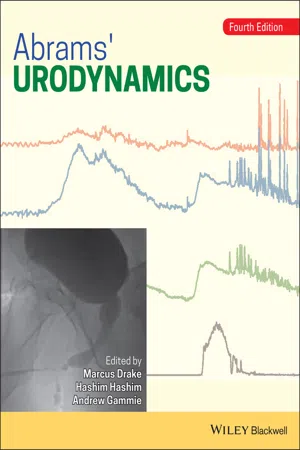
Abrams' Urodynamics
- English
- ePUB (mobile friendly)
- Available on iOS & Android
Abrams' Urodynamics
About this book
A complete guide to urodynamic investigation in modern health care
Urodynamic testing is an ever-advancing field with applications in the management of patients from across a wide range of clinical areas. Bringing together fundamental principles and cutting-edge innovations, Abrams' Urodynamics has been designed as an all-in-one guide to Functional Urology and Urogynecology, offering direct, up-to-date instruction on how to best perform and understand urodynamic tests within the overall treatment pathway. Its chapters cover everything from everyday basic practice to advanced complex cases, and are enhanced with more than 450 helpful illustrations. Including numerous revisions and new features, this fourth edition of the book boasts:
- Coverage of all investigative approaches, including uroflowmetry, cystometry, video-urodynamics, and non-invasive techniques
- Details on the successful running of a urodynamic unit, with information on organizational issues, equipment set-up, and common problems and pitfalls
- Sections addressing children, women, men, the elderly, and neuropaths
- Extensive description of International Continence Society (ICS) Standards throughout
- Appendices that include ICS Standards and Fundamentals documents, ICIQ modules, and Patient Information Leaflets
With its wealth of clinical tips, illustrations, new innovations, and hands-on advice, Abrams' Urodynamics is essential reading for all those wishing to better integrate urodynamic testing into their daily practice.
Frequently asked questions
- Essential is ideal for learners and professionals who enjoy exploring a wide range of subjects. Access the Essential Library with 800,000+ trusted titles and best-sellers across business, personal growth, and the humanities. Includes unlimited reading time and Standard Read Aloud voice.
- Complete: Perfect for advanced learners and researchers needing full, unrestricted access. Unlock 1.4M+ books across hundreds of subjects, including academic and specialized titles. The Complete Plan also includes advanced features like Premium Read Aloud and Research Assistant.
Please note we cannot support devices running on iOS 13 and Android 7 or earlier. Learn more about using the app.
Information
Part I
Basic Principles
1
Basic Urodynamics and Fundamental Issues
Introduction to Urodynamics
- To reproduce the patient's symptomatic complaints while making key observations
- To provide a pathophysiological explanation by correlating the patient's symptoms with the urodynamic findings
| Storage | Voiding | Post‐micturition |
|---|---|---|
| Urgency | Slow stream | Post‐micturition dribbling |
| Urinary incontinence | Splitting/spraying | Feeling of incomplete emptying |
| Increased daytime frequency | Intermittency | |
| Nocturia | Hesitancy | |
| Pain | Straining | |
| Terminal dribbling |


Table of contents
- Cover
- Table of Contents
- Title Page
- Copyright Page
- Abbreviations
- Contributors
- Preface
- First Foreword
- Second Foreword
- Part I: Basic Principles
- Part II: Functional Urology
- Part III: Urodynamic Techniques
- Part IV: Urodynamics in Clinical Practice
- Part V: Running a Urodynamics Unit
- Appendix A: Key Patient Assessment Metrics from the International Consultation on Incontinence Questionnaires (ICIQ)
- Appendix B: Fundamentals Documents from the International Continence Society
- Appendix C: Patient Information Leaflets from the Bristol Urological Institute
- Appendix D: Practice, Standards, and Equipment Recommendations
- Index
- End User License Agreement